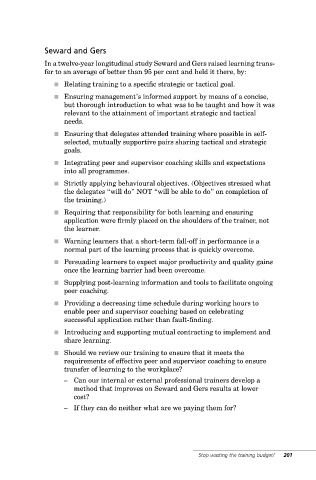Page 232 - SKU-000506274_TEXT.indd
P. 232
Seward and Gers
In a twelve-year longitudinal study Seward and Gers raised learning trans-
fer to an average of better than 95 per cent and held it there, by:
n Relating training to a specific strategic or tactical goal.
n Ensuring management’s informed support by means of a concise,
but thorough introduction to what was to be taught and how it was
relevant to the attainment of important strategic and tactical
needs.
n Ensuring that delegates attended training where possible in self-
selected, mutually supportive pairs sharing tactical and strategic
goals.
n Integrating peer and supervisor coaching skills and expectations
into all programmes.
n Strictly applying behavioural objectives. (Objectives stressed what
the delegates “will do” NOT “will be able to do” on completion of
the training.)
n Requiring that responsibility for both learning and ensuring
application were firmly placed on the shoulders of the trainer, not
the learner.
n Warning learners that a short-term fall-off in performance is a
normal part of the learning process that is quickly overcome.
n Persuading learners to expect major productivity and quality gains
once the learning barrier had been overcome.
n Supplying post-learning information and tools to facilitate ongoing
peer coaching.
n Providing a decreasing time schedule during working hours to
enable peer and supervisor coaching based on celebrating
successful application rather than fault-finding.
n Introducing and supporting mutual contracting to implement and
share learning.
n Should we review our training to ensure that it meets the
requirements of effective peer and supervisor coaching to ensure
transfer of learning to the workplace?
– Can our internal or external professional trainers develop a
method that improves on Seward and Gers results at lower
cost?
– If they can do neither what are we paying them for?
Stop wasting the training budget! 201

